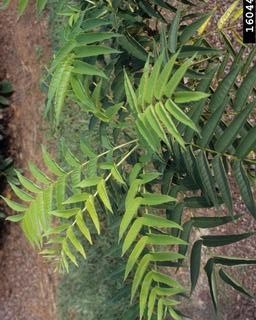Ailanthus-like prickly ash
(Zanthoxylum ailanthoides)

Description
Zanthoxylum ailanthoides, also called ailanthus-like prickly ash, is an Asiatic plant of the prickly-ash genus Zanthoxylum, natively occurring in forest-covered parts of southeastern China, Taiwan, Southeast Asia, and Japan from Honshu southward. The piquant fruit serves as a local "substitute for the ordinary red-pepper" in China. In Taiwan, the young leaves are used in cuisines. Zanthoxylum is a genus of about 250 species of deciduous and evergreen trees, shrubs and climbers in the family Rutaceae that are native to warm temperate and subtropical areas worldwide. It is the type genus of the tribe Zanthoxyleae in the subfamily Rutoideae. Several of the species have yellow heartwood, to which their generic name alludes. The genus Zanthoxylum was first formally described in 1753 by Carl Linnaeus in the first volume of Species Plantarum. It refers to a yellow dye made from the roots of some species. The first species that Linnaeus described was Zanthoxylum trifoliatum, now regarded as a synonym of Eleutherococcus trifoliatus. The once separate genus Fagara is now included in Zanthoxylum. Zanthoxylum is a genus of about 250 species of deciduous and evergreen trees, shrubs and climbers in the family Rutaceae that are native to warm temperate and subtropical areas worldwide. It is the type genus of the tribe Zanthoxyleae in the subfamily Rutoideae. Several of the species have yellow heartwood, to which their generic name alludes. Plants in the genus Zanthoxylum are typically dioecious shrubs, trees or woody climbers armed with trichomes. The leaves are arranged alternately and are usually pinnate or trifoliate. The flowers are usually arranged in panicles and usually function as male or female flowers with four sepals and four petals, the sepals remaining attached to the fruit. Male flowers have four stamens opposite the sepals. Female flowers have up to five, more or less free carpels with the styles free or sometimes fused near the tip. The fruit is usually of up to four follicles fused at the base, each containing a single seed almost as large as the follicle. The genus Zanthoxylum was first formally described in 1753 by Carl Linnaeus in the first volume of Species Plantarum.
Taxonomic tree:







